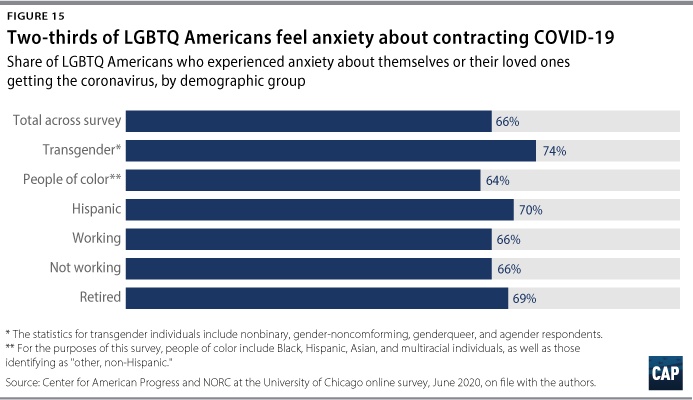More than 1 in 3 LGBTQ Americans faced discrimination in the past year
At a basic level, this study finds many LGBTQ individuals reporting mistreatment in their public, work, and personal lives. Asked, “In the past year, have you experienced discrimination of any kind based on your race or ethnicity, national origin, sex, gender identity, sexual orientation, religion, disability, economic status, immigration status, or age?” more than one-third of LGBTQ people—36 percent of respondents—said they had. Among transgender individuals,2 this number increases dramatically, with 62 percent reporting discrimination in the past year.
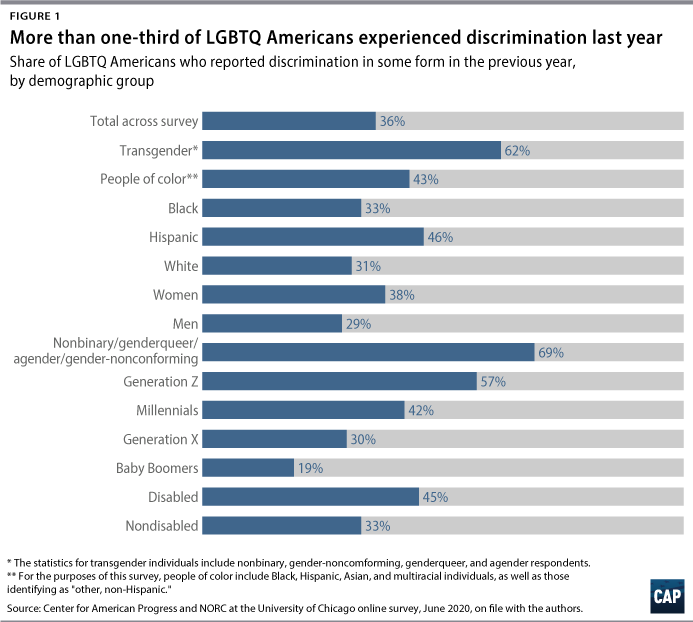
As seen in Figure 1, reported discrimination is higher than average among transgender and nonbinary people, those with a disability, and individuals of color,3 particularly Hispanic individuals. Forty-three percent of respondents of color reported experiencing discrimination in some form in the past year, compared with 31 percent of white LGBTQ respondents. Among individuals specifically identifying as nonbinary, genderqueer, agender, or gender nonconforming, nearly 7 in 10 (69 percent) reported discrimination in the past year. Similarly, 45 percent of disabled respondents reported discrimination in the year prior. Generational differences within the LGBTQ community are also prominent: 57 percent of Generation Z adults and 42 percent of Millennials reported discrimination of some kind in the past year, compared with 30 percent of Generation Xers and about one-fifth of Baby Boomers.
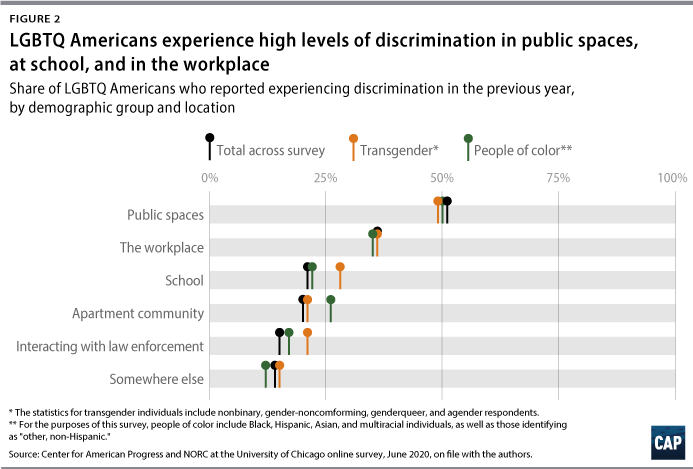
In terms of where or how these incidents of discrimination occurred, more than half (51 percent) of LGBTQ respondents overall said they experienced harassment or discrimination in a public place such as a store, public transportation, or a restroom; 36 percent in the workplace; 21 percent at school; 20 percent in an apartment community; 15 percent through interactions with law enforcement; and 14 percent somewhere else. (Multiple responses were allowed.)
Among Gen Z adults in the community, school was the likeliest place to encounter discrimination, at 46 percent, compared with 41 percent in public places.
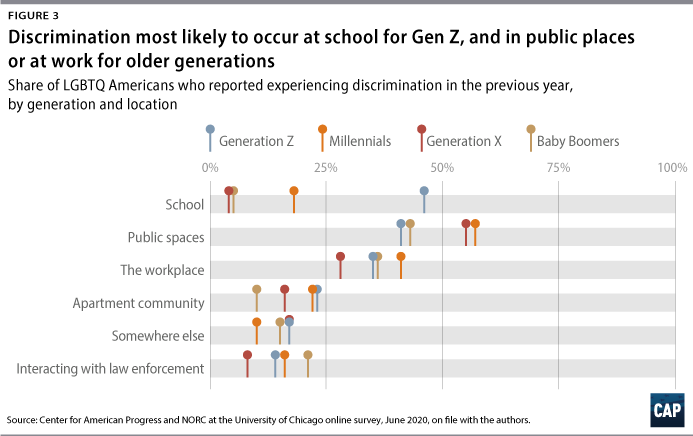
Respondents were asked to rate the degree to which discrimination affected their life, with the options “not at all,” “slightly,” “moderately,” and “to a significant degree.” Transgender respondents were among those facing particularly high levels of discrimination in everyday life. More than half (56 percent) reported that discrimination had a moderate or significant negative impact on their school environment. More than one-third (37 percent) said that discrimination had a moderate or significant impact on their ability to rent or buy a home; 28 percent of LGBTQ respondents overall reported the same. More than half (51 percent) experienced moderate or significant impacts of discrimination in trying to obtain accurate ID documents, an issue especially prominent among transgender individuals seeking documents that accurately reflect their name and gender identity.
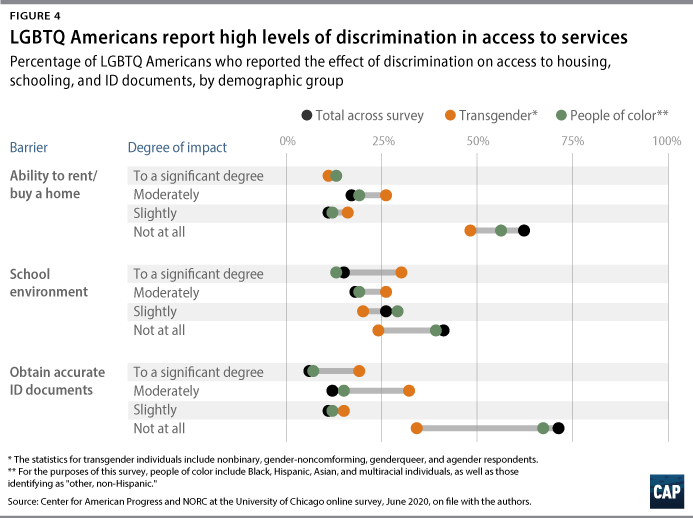
Discrimination harms LGBTQ Americans’ psychological and economic well-being
The experience of discrimination clearly takes its toll on the psychological and physical well-being of many LGBTQ people as well as on their income and job opportunities.
The study presented respondents with a series of areas and asked them to assess to what degree discrimination has negatively affected them in each area. At the top of the list of negative consequences, 52 percent of LGBTQ people said that their “psychological well-being” has been negatively affected to a moderate or significant degree in the past year. Another 36 percent of respondents reported moderate to significant negative impacts from discrimination on their “spiritual well-being,” and 32 percent reported similarly for their “physical well-being.” The definitions of these categories were open to the personal interpretation of the respondents.
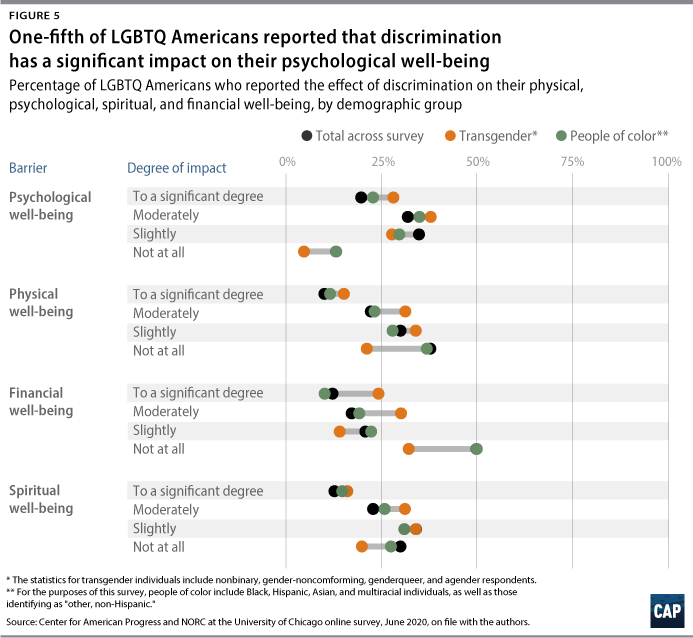
Transgender individuals experienced noticeably high rates of physical, psychological, and spiritual harm due to discrimination. Two-thirds (66 percent) reported that discrimination moderately or significantly affected their psychological well-being, with nearly half (46 percent) reporting moderate or significant physical impacts and 47 percent reporting moderate or significant impacts on spiritual well-being.
The effect of discrimination on multiple dimensions had significant impacts on Black respondents. Nearly 4 in 5 Black individuals (77 percent) reported moderate or significant impacts to their psychological well-being, while nearly two-thirds (65 percent) reported moderate or significant impacts to their physical well-being.
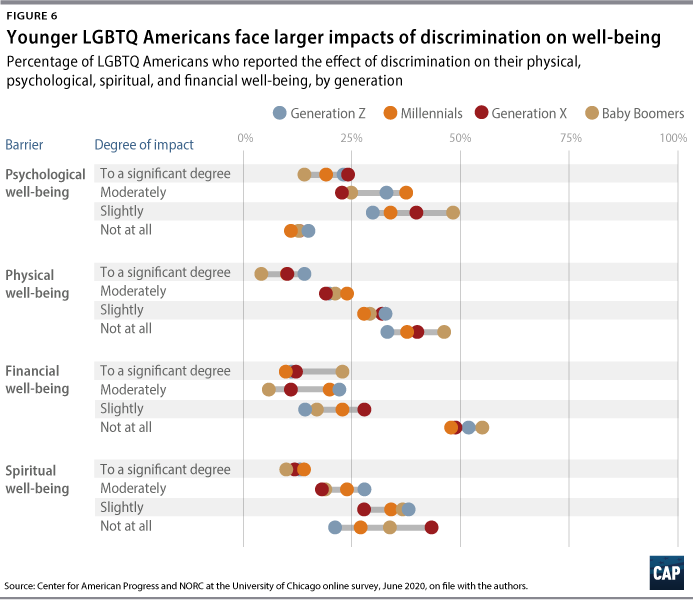
More than half of Gen Z and Millennial respondents reported moderate or significant negative impacts on their psychological well-being from discrimination, compared with less than half of Gen Xers and about 4 in 10 Baby Boomers.
Discrimination also appears to affect the economic security of LGBTQ individuals. Nearly one-third of respondents (29 percent) reported that discrimination moderately or significantly affected their financial well-being—including 37 percent of Black respondents and more than half (54 percent) of transgender respondents.
Respondents also reported troubles at work. More than one-third of LGBTQ Americans (35 percent) said their ability “to be hired” has been negatively affected to a moderate or significant degree in the past year due to discrimination, along with about 3 in 10 people (31 percent) who have faced negative impacts on their “salary or ability to be promoted” or their “ability to retain employment.”
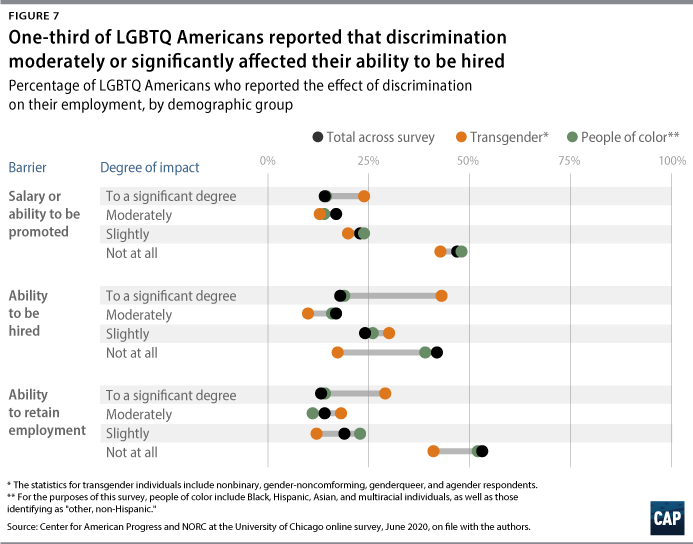
Transgender individuals expressed the greatest difficulty in employment discrimination. More than half (53 percent) of transgender individuals expressed that discrimination moderately or significantly affected their capacity to be hired, with 4 in 10 saying that their ability to be hired was negatively affected to a significant degree. Nearly half (47 percent) of transgender respondents reported that discrimination had a moderate or significant impact on their ability to retain employment. Fifty-one percent of Black respondents reported that discrimination moderately or significantly affected their ability to be hired, compared with 33 percent of white respondents, and 41 percent reported that it had a moderate or significant impact on their ability to retain employment, compared with 31 percent of white respondents. While Baby Boomers reported lower rates of negative impacts from discrimination on their psychological or physical well-being, they were the most likely generation to report that discrimination negatively affected their ability to be hired, their ability to retain employment, and their financial well-being to a significant degree.
These effects appear larger among lower-income LGBTQ Americans than among higher-income ones: Nearly half (47 percent) of those earning less than $25,000 per year reported negative impacts from discrimination on their ability to be hired, compared with around one-quarter (26 percent) of those making more than $100,000 annually.
Many LGBTQ Americans hide their relationships or alter their personal or work lives to avoid discrimination
The survey asked respondents, “Which of the following things have you done in order to avoid experiencing discrimination because of your sexual orientation, gender identity, and/or some other characteristic?” As seen in Table 1, a full 54 percent of LGBTQ Americans say that they have “hid a personal relationship”—by far the most widespread action taken to avoid experiencing discrimination.
College-educated and younger LGBTQ individuals are more likely than noncollege-educated and older ones to report hiding a personal relationship from others. Sixty-two percent of college-educated LGBTQ Americans and two-thirds of Gen Zers say they have hidden a relationship, compared with less than half of noncollege-educated ones and about half of Gen Xers or Baby Boomers.
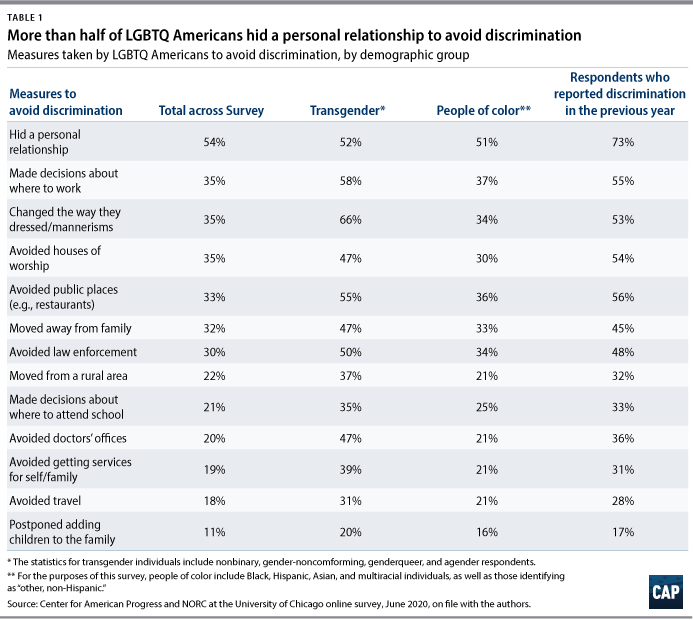
The next tier of actions taken by about one-third of LGBTQ people to avoid discrimination includes a range of steps, from avoiding public places or houses of worship, to moving away from family, to deciding where to work, to changing individual dress or mannerisms. For example, 35 percent of LGBTQ people say they have “made specific decisions about where to work” in order to avoid discrimination, with one-third also reporting having “avoided public places like stores or restaurants.” Transgender and college-educated individuals are more likely than others to have avoided potentially discriminatory workplaces. Three in 10 respondents also reported avoiding law enforcement to prevent discrimination, including 50 percent of transgender respondents and 40 percent of Black respondents.
Likewise, approximately one-third of LGBTQ people say they have “moved away from family,” and just more than one-fifth have “moved away from a rural area” to avoid discrimination. In terms of demographic differences, Black and transgender respondents were more likely than others to have moved away from family to avoid discrimination, while those living in nonmetro areas were more likely than those living in metro areas to have changed their dress or mannerisms to avoid discrimination.
About one-fifth of LGBTQ people have taken a third tier of steps to avoid discrimination, including “avoiding travel” (18 percent); “avoiding getting services” (19 percent); “avoiding doctor’s offices” (20 percent); and making “specific decisions about where to go to school” (21 percent). These avoidance behaviors were even more common among respondents who experienced discrimination in the past year.
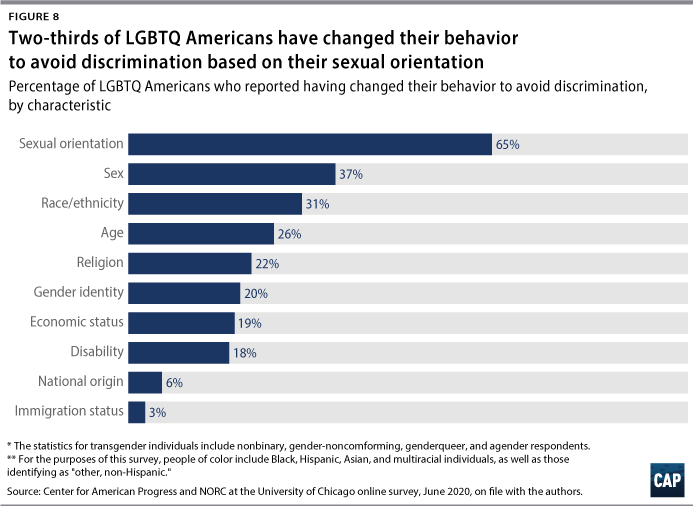
As seen in Figure 8, in terms of the personal characteristics that may have caused people to alter their behaviors, nearly two-thirds of respondents say their “sexual orientation” has led to changed behavior. Thirty-seven percent of respondents selected “sex” as well, including 55 percent of transgender respondents and 38 percent of women versus 24 percent of men. “Race” was chosen by 31 percent of respondents overall, nearly 6 in 10 Black respondents, and more than 4 in 10 Hispanic respondents. Sixty-eight percent of transgender respondents listed “gender identity.” “Age” was selected by about one-quarter of respondents, with about one-fifth listing “religion” or “economic status” as personal characteristics that have led LGBTQ people to change their behaviors.
The study also asked respondents to gauge how difficult it would be for them to find a different location if they were denied service in a range of areas. As shown in Figure 9, more than 4 in 10 LGBTQ Americans overall said that finding a different homeless shelter or adoption agency would be very difficult if not impossible if they faced a denial of service. Reported difficulties in finding alternative services in these two areas are even higher for transgender people.
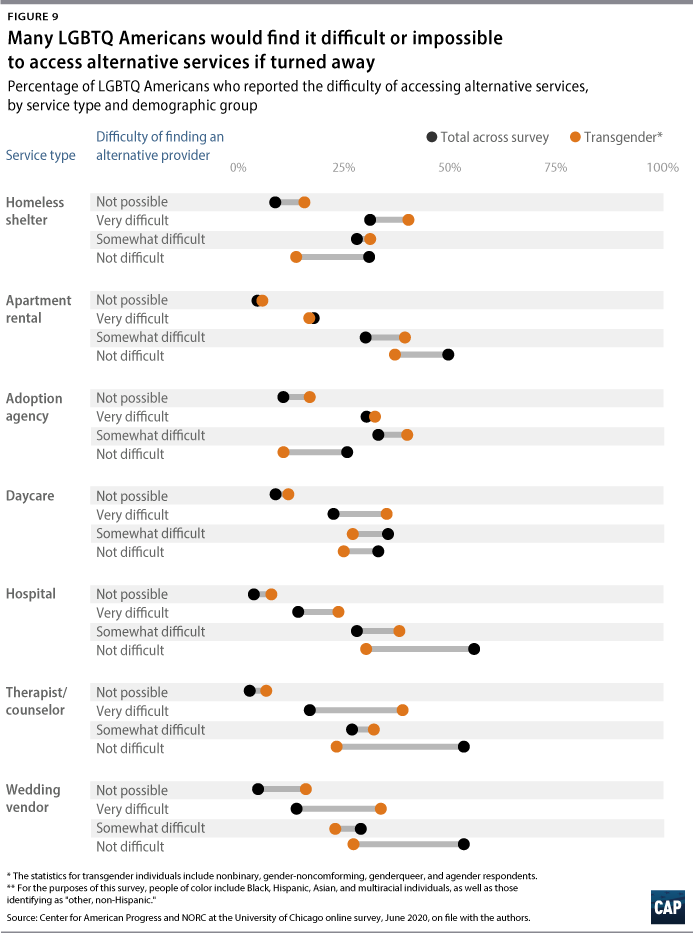
Additionally, approximately one-third of respondents said that it would be very difficult or impossible to find different places to rent an apartment or to get daycare, with around one-fifth of LGBTQ people saying it would be very difficult or impossible to find alternative hospitals, therapists, or wedding vendors if they were denied service.
Due to cost, many LGBTQ Americans found it hard to get necessary medical care in the past year
The study also assessed whether LGBTQ people have experienced any difficulties when trying to access medical care or preventive screenings in the past year. As seen in Figure 10, cost issues affect the largest percentage of LGBTQ individuals. Twenty-nine percent of respondents said that in the past year, “I have postponed or not tried to get medical care when I was sick or injured because I could not afford it,” with another one-quarter saying they have postponed preventive screenings due to costs. Among transgender respondents, 51 percent have postponed or avoided care due to cost, and 40 percent have avoided or postponed preventive screenings due to cost.
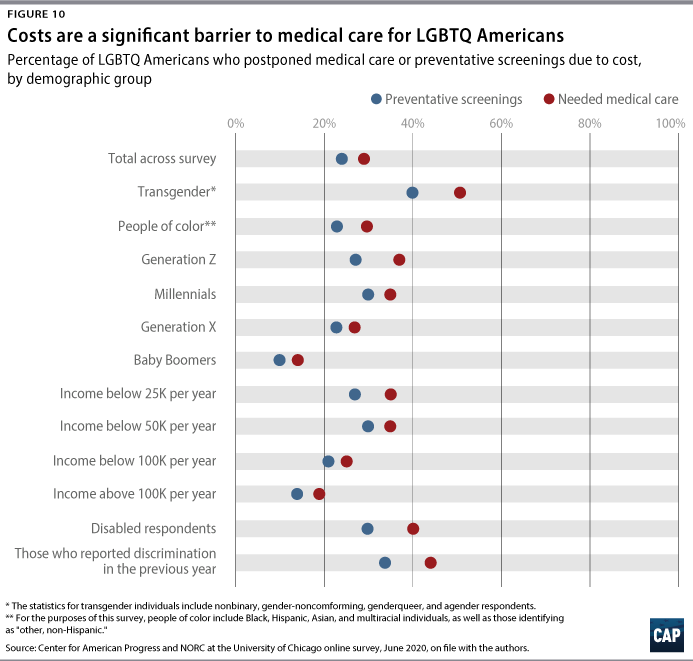
Although 88 percent of LGBTQ Americans overall say they have health insurance, mostly through an employer or government sponsored exchange or Medicaid, cost pressures pose a particular challenge for younger generations in the community. For example, Gen Z LGBTQ adults are three times more likely than Baby Boomers to have postponed necessary medical care in the past year due to costs (37 percent versus 14 percent, respectively).
Even though costs are a primary challenge, there is a strong desire for equal treatment and good training among health care professionals. Sixty-eight percent of LGBTQ respondents said that it is very important to them that health care providers they see have nondiscrimination policies and specific training in working with LGBTQ people.
Many LGBTQ Americans did not pursue medical treatment due to discrimination
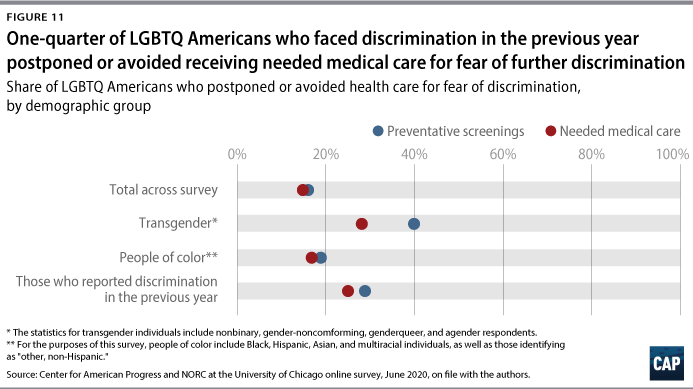
Although costs appear to be a more widespread barrier, discriminatory experiences have also prevented LGBTQ Americans from seeking medical assistance: 15 percent of respondents overall, including 28 percent of transgender respondents, reported postponing or avoiding needed medical care when they were sick or injured due to disrespect or discrimination. Sixteen percent of respondents overall, including 40 percent of transgender respondents, reported postponing or avoiding preventive screenings due to discrimination. Among LGBTQ people who specifically reported experiencing some form of discrimination in the year prior, 36 percent reported avoiding doctor’s offices to avoid discrimination compared with 20 percent of respondents overall—a sign that facing discrimination makes one less likely to seek out necessary services.
Exploring the issue in more depth, the study asked respondents whether they have experienced a series of specific challenges with doctors or other health care providers. Twelve percent of respondents overall say they have had to teach their doctors or other providers about their community in order to get adequate treatment. And as seen in Figure 12, anywhere from 7 percent to 14 percent of LGBTQ people have had other negative experiences, including a doctor or provider being visibly uncomfortable due to their actual or perceived sexual orientation (14 percent); harsh or abusive language (8 percent); doctors or providers intentionally refusing to recognize their family members (8 percent); or unwanted physical contact (7 percent).
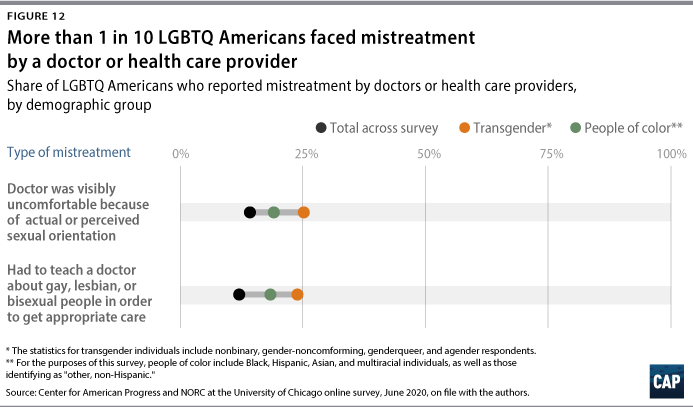
In general, younger generations across the LGBTQ community are more likely to report specific negative experiences with doctors or health care providers than are those of older generations.
Transgender individuals face unique obstacles when accessing health care
Transgender people, in particular, express more problems in health care than any other segment of the community. Thirty-three percent of respondents reported having to teach their doctor or provider about transgender people in order to get appropriate care. Thirty-eight percent of transgender Americans said that their doctors or other providers have been visibly uncomfortable with them because of their gender identity, and 25 percent said that health care professionals refused to give them medical treatment related to their gender transition. Thirty-two percent of respondents noted that a doctor or provider had intentionally misgendered them or used the wrong name. Nineteen percent reported that their doctor or provider used harsh or abusive language while treating them; 20 percent reported doctors or providers had been physically rough or abusive; and 18 percent reported that their doctor or provider refused to see them at all because of their actual or perceived gender identity.
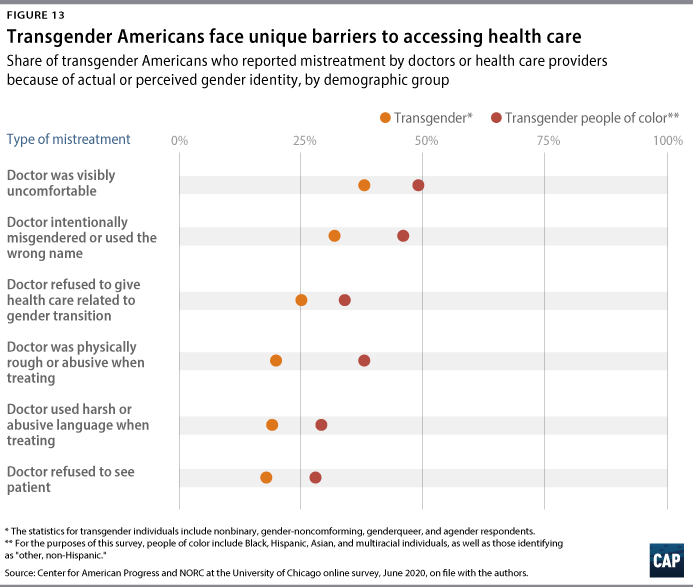
These concerns are even more prominent among transgender respondents of color. Twenty-eight percent reported that a doctor or provider refused to see them because of actual or perceived gender identity. Twenty-nine percent reported a doctor or other provider used harsh or abusive language when treating them. Thirty-four percent reported doctors or providers refused to provide health care related to gender transition. Thirty-eight percent reported a doctor or provider was physically rough or abusive when treating them. Nearly half (49 percent) reported that their doctor or provider was visibly uncomfortable while treating them, with a similar share (46 percent) reporting that they were intentionally misgendered.
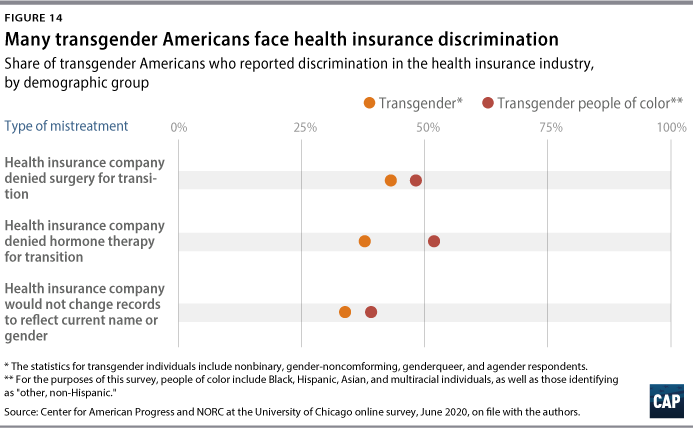
Likewise, 43 percent of transgender people said their health insurance company denied them surgery for their transition, and another 38 percent—including 52 percent of transgender respondents of color—said that their insurance company denied them hormone therapy for their transition. Thirty-four percent reported that an insurance company would not change their records to reflect their current name or gender.
LGBTQ Americans have experienced significant mental health issues related to COVID-19
Overall, two-thirds of LGBTQ Americans say they are anxious about the possibility that they or one of their loved ones will get the coronavirus. Retired individuals, disabled individuals, and Hispanic individuals express more anxiety than others about contracting COVID-19, but concern crosses the entire community.4
More specifically, as seen in Table 2, 69 percent of LGBTQ people reported problems in the past two weeks with feeling nervous or anxious when thinking about the coronavirus. Thirty-five percent of these respondents said they felt nervous or anxious for several days, and another 34 percent felt this way for more than half of the days or nearly every day over a two-week period.
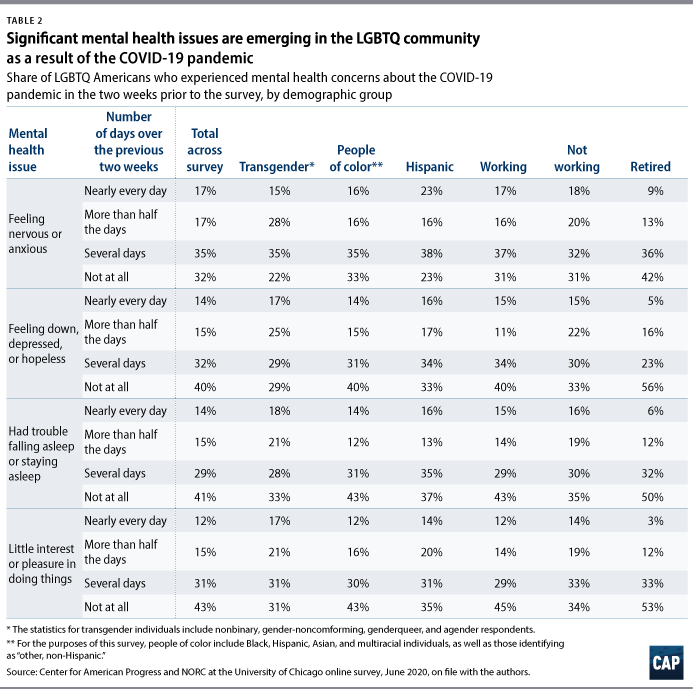
Slightly smaller proportions of respondents reported mental health challenges on other measures. For example, roughly 6 in 10 felt down, depressed, or hopeless or reported having trouble falling or staying asleep due to thinking about the coronavirus. Fifty-four percent of LGBTQ people experienced not being able to stop or control their worrying, and 58 percent felt little interest or pleasure in doing things for at least several days over a two-week period. As on other measures, transgender people reported higher levels of mental health issues than most other groups when thinking about the coronavirus.
